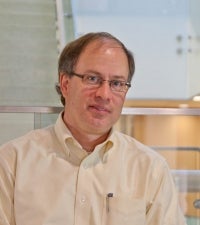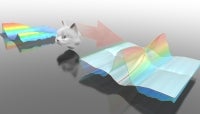Our paper on 2D colinear optical photocurrent spectroscopy has been published in Optics Express.
Author Archives: Gabriel Palmer Pompilius
Physics Today article on multidimensional spectroscopy published
An article authored by Shaul Mukamel and Steven Cundiff on Optical Multidimensional Coherent Spectroscopy appeared in the July issue of Physics Today. http://www.physicstoday.org/resource/1/phtoad/v66/i7/p44_s1
Physics Today article on multidimensional spectroscopy published
An article authored by Shaul Mukamel and Steven Cundiff on Optical Multidimensional Coherent Spectroscopy appeared in the July issue of Physics Today.
Galan Moody defends his thesis.
Galan Moody successfully defended his thesis on June 20th. Congratulations Galan!
Galan Moody defends his thesis.
Galan Moody successfully defended his thesis on June 20th. Congratulations Galan!
3DFT paper selected as Editors Choice in Science
Our 3D Fourier transform paper in Nature Communications featured as Editors Choice in Science.
3DFT paper selected as Editors Choice in Science
Our 3D Fourier transform paper in Nature Communications featured as Editors Choice in Science.
The Pathfinder

The Cundiff group’s new 3D Fourier-transform spectroscopy technique (modeled as 3D movie glasses) allows researchers to peer inside the quantum world and identify quantum pathways between different states. The pathways are determined from measurements of the real experimental spectra reflected in the lenses. Credit: Hebin Li (Cundiff group) and Brad Baxley, JILA
The Cundiff group has taken an important step forward in the study of the quantum world. It has come up with an experimental technique to measure key parameters needed to solve the Schrödinger equation.
The amazing Schrödinger equation describes the time-dependent evolution of quantum states in a physical system such as the group’s hot gas of potassium atoms (K). But, for the equation to work, someone has to figure out a key part of the equation known as the Hamiltonian. Unfortunately, Hamiltonians are really complicated for most real-life systems because they characterize a multitude of quantum states and pathways that exist inside a roiling quantum world.
For experiments involving many atoms or other particles that interact with each other and their environment, the only hope of ever figuring out the correct Hamiltonian may be to do it experimentally. And, the Cundiff group has just taken a giant step toward the goal of doing exactly that.
In a new Nature Communications paper, research associate Hebin Li, former research associates Alan Bristow and Mark Siemens, graduate student Galan Moody, and Fellow Steve Cundiff report on their nifty new technique known as optical three-dimensional (3D) Fourier-transform spectroscopy. They used the technique to produce detailed spectra of a gas of hot (180 ºC) K atoms. The spectra allowed them to see exactly what was happening inside the quantum world of the atoms in their experiment.
Specifically, the researchers were able to disentangle all possible pathways between specific initial conditions of the K atoms (typically ground states) and final conditions (such as excited states or quantum mechanical superposition states). And, once they had identified all possible pathways, the researchers were able to make measurements necessary for characterizing the pathways. With this information, they were able to figure out some pieces of the Hamiltonian they needed.
Li and his colleagues are excited about the many possibilities of their new technique, including the dream of coherently controlling chemical reactions. Coherent control requires an understanding of all possible quantum pathways in a particular reaction. The fact that 3D Fourier-transform spectroscopy made it possible to identify all these pathways is a huge step forward in realizing this dream.
The new technique is also a huge step towards being able to experimentally determine a Hamiltonian for an even more complex system. Stay tuned.
Steve Cundiff Wins Silver Medal for JILA’s New X-Wing
 Steve Cundiff will receive a Silver Medal from the U. S. Department of Commerce for his leadership of JILA’s X-Wing project at an award ceremony to be held in Washington, D. C. on January 8, 2013. He is also being honored for this achievement during the 40th annual NIST Awards Ceremony at NIST in Gaithersburg, Maryland on December 5, 2012.
Steve Cundiff will receive a Silver Medal from the U. S. Department of Commerce for his leadership of JILA’s X-Wing project at an award ceremony to be held in Washington, D. C. on January 8, 2013. He is also being honored for this achievement during the 40th annual NIST Awards Ceremony at NIST in Gaithersburg, Maryland on December 5, 2012.
Schrödinger Cats Light the Way

From the response of the material to normal laser light (left), the effects due to a Schrödinger Cat state can be calculated (right). Credit: The Cundiff group and Brad Baxley, JILA
We can get valuable information about a material by studying how it responds to light. But up to now, researchers have been forced to ignore how some of light’s stranger quantum behavior, such as being in a superposition of one or more intensity states, affects these measurements. New research from the Cundiff group (with newly minted PhD Ryan Smith and graduate student Andy Hunter) has shown that it is possible to back-calculate how a semiconductor responds to light’s quantum features even though we can’t directly create light with those features. This work was built upon theory developed by collaborators at the University of Marburg in Germany. The resulting new method of “quantum spectroscopy” opens the door to a deeper understanding of semiconductor properties.
Spectroscopy is a time-tested method for investigating the properties of materials such as semiconductors. Researchers shine a laser on a sample and see what happens. They infer information about the material from these observations. This process is similar to deducing information about a piece of window glass by looking at the transmitted sunlight on the other side.
In the laboratory, scientists can vary aspects of the probe laser, such as its color and intensity or how long it shines on the sample. But there is more to light than these familiar wave-like properties. A beam of light can also be seen as a stream of particles called photons, which have hidden – and often strange – quantum mechanical properties. For instance, we do not yet have the technological capability look inside light and see superpositions of different intensities. And accurate theoretical predictions are challenging in complicated systems like semiconductors. Consequently, researchers have remained in the dark about how these properties of light might affect spectroscopy experiments.
To illuminate the effects of light’s quantum features, Cundiff and his colleagues have been working on developing a new type of spectroscopy. Since they can’t tune a laser to emit light with particular quantum properties, they instead measure a sample’s response as the light intensity from a typical laser is varied. Using this information and theory developed by the group at Marburg University, they back-calculate how the system would respond if they had manipulated the quantum nature of the light in what is called a Schrödinger Cat state (Figure 1).
This technique works because light in a Schrödinger Cat state can be mathematically reconstructed by adding together two different intensities of normal laser light. But, here’s where the quantum weirdness comes in: If we could make a detector that could measure the intensity of Schrödinger Cat light, it either would measure one of two intensities or the other, but not something in between. Like the mythical cat of the same name (which is simultaneously both ‘alive’ and ‘dead’ until you open the box), Schrödinger Cat light has two intensities simultaneously. Even though they can’t yet make such light in the lab, the Cundiff team was able reconstruct the effects of Schrödinger Cat light on the sample by adding together the effects of the regular laser light intensities that make up cat light.
Naturally, the response of a material to light’s quantum behavior isn’t straightforward: it only shows up as higher-order “wiggles” in the material’s absorption that are only visible when the light is intense enough. It’s like hitting a piano key hard. If you bang on the key, you not only hear that note, but also several other higher tones set off by the hammer. These overtones are called higher harmonics.
The Cundiff group “listened” for those higher harmonics in the absorption of the semiconductor. To see them, the researchers hit a sample of a gallium-arsenide (GaAs) semiconductor with laser pulses of varying high intensities and correlated the laser intensity with resulting changes in the sample’s absorption of a probe laser pulse.
“That’s not particularly new,” said Cundiff. “People have been doing this forever.” “The key thing that we did is that we did it carefully.” Adding together the results of careful measurements allowed the researchers to then reconstruct the response of the sample to Schrödinger Cat light.
This work is particularly exciting because it shows that light’s quantum features are important in how a material responds to light. And, the methods suggest a way to apply this quantum-optical spectroscopy in a variety of complex materials. The understanding gained from these experiments could lead to customized optoelectronics devices such as semiconductor lasers. — Stephanie Chasteen


